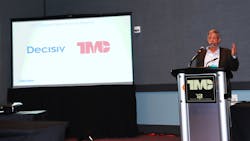Maintenance, repair costs rose in Q4 2021: TMC benchmarking
According to the latest quarterly Decisiv/TMC North American Service Event Benchmark Report, fleets experienced a confluence of rising costs in the final quarter of 2021.
These include a labor cost increase of 14.2% year-over-year and a YOY parts cost increase of 8.8%. Combined parts and labor costs during that time jumped nearly 11%.
From Q3 to Q4 of last year, labor costs increased 5.4%, while parts cost rose 2.7%. According to the report, Q4 2021 saw the average cost of parts and labor for vehicle repairs rise 3.7%. This was mainly attributed to the higher labor costs.
See also: More TMC 2022 coverageSeveral factors drove the rise in labor and parts costs, Decisiv reported. The supply chain and inflation issues impacted parts prices, while additional repairs to higher mileage vehicles and the highly competitive labor market caused the uptick in labor.
Those numbers were released at TMC’s 2022 Annual Meeting & Transportation Technology Exhibition and come from Decisiv’s SRM platform, which Mark Wasilko, Decisiv VP of marketing, said captures about 1 million service events monthly and roughly 3 million per quarter. The platform tracks service and repair events for more than 7 million commercial assets in the U.S. and Canada. About 74,000 fleets plug into the SRM.
“The North American economy continues to impact parts and labor costs for fleets in several ways,” said Decisiv President and CEO Dick Hyatt. “However, the ongoing drive to implement more effective and intelligent service management practices among fleet maintenance operations is helping ensure the highest possible levels of equipment utilization.”
VMRS data
“Data can drive shop efficiency to greater heights, but you need the right type of data,” Wasilko said.
Vehicle maintenance reporting standards (VMRS) provide a lot of this right kind of data.
“It’s a great system that fleets should be using,” Wasilko said. “The adoption and the use of the [VMRS] system guarantees a much higher level of accuracy.” This is in terms of recording costs, and both vendor and dealer performance analysis.
Using VMRS System Level Coding, the report broke down exactly where fleets spent the most in Q4:
- Power plant: 36.8%
- Exhaust systems: 14.9%
- Brakes: 5.0%
“You can see just by using the system code, which is basically the nine-digit component code, the data you can come up with,” added Jack Poster, TMC’s VMRS services manager. “We're hoping down the road to go to the system assembly, which will then even get more granular. [But] we have to be careful that we make sure the data is correct.”
Decisiv attributed the brakes cost increase to increased mileage, while higher engine and exhaust system-related costs were likely due to fleets keeping vehicles in service longer as trade cycles were extended. This in turn was from manufacturers lowering production output during the pandemic, as labor and parts were harder to come by.
“VMRS it's still probably the most important and valuable piece of information that a fleet can have. It points you in the right direction,” said Paul Gildenhorn, VP of sales at FleetNet America, who then followed with more benchmarking data.
Among those was that two-thirds of all repairs done were from the top five VMRS codes.
FleetNet data
Gildenhorn had some curious data to relay based on the latest TMC/FleetNet Vertical Benchmarking Report, now in its fifth year.
One anomaly he pointed to was fleets running fewer miles in Q4 than Q3, despite the typical increase due to consumers’ holiday behavior. Ecommerce, fear of supply shortages, and port congestion turned the tides, he said.
On the positive side, fleets extended miles between breakdowns.
“With the parts shortages and the technician shortages and the labor costs and availability of equipment throughout last year, fleets are having to spend more time paying closer attention to their preventive maintenance programs than ever before,” Gildenhorn surmised.
He recalled a conversation with someone from one of the participating fleets who revealed they were still waiting for a trailer that was ordered two years ago.
“Right now fleets are focused on just getting their equipment fixed or hopefully getting equipment to replace the older equipment,” Gildenhorn said.
Because fleet managers’ time is so valuable and the challenges so many, Gildenhorn said FleetNet, and the data management sector in general, will continue to advance and provide enhanced features.
“Data continues to come faster and better than ever before, from a multitude of different places—from maintenance data to telematics—so there's a lot to concentrate on,” he concluded.
This article originally appeared on Fleet Maintenance.
About the Author
John Hitch
Editor
John Hitch is the editor-in-chief of Fleet Maintenance, providing maintenance management and technicians with the the latest information on the tools and strategies to keep their fleets' commercial vehicles moving. He is based out of Cleveland, Ohio, and was previously senior editor for FleetOwner. He previously wrote about manufacturing and advanced technology for IndustryWeek and New Equipment Digest.

